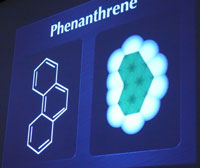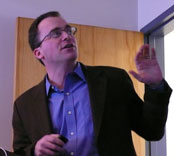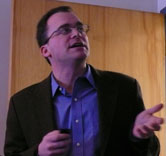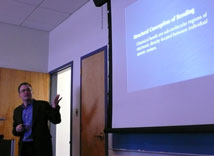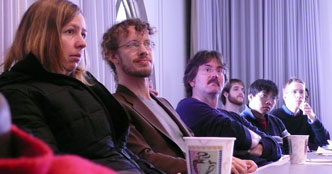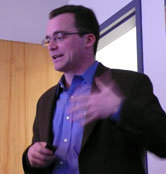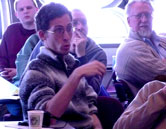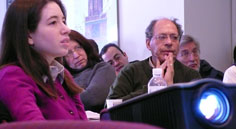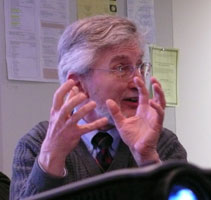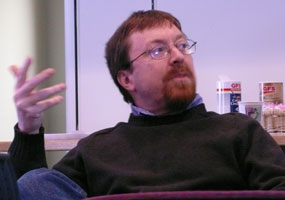
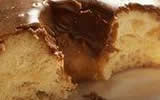
![]()
::: postdoc fellowships
::: senior fellowships
::: resident fellowships
::: associateships
![]()
being here
::: visiting
::: the last donut
::: photo album
::: center home >> being here >> last donut? >> 16 february 2007 |
Friday, 16 January 2007 Michael Weisberg had driven up the turnpike from Philadelphia to be our Friday speaker. That would not normally be so remarkable. However an ice storm on Wednesday had stranded many motorists on the interstates, so we were all relieved when he and Deena Skolnick Weisberg arrived safely on Thursday. (Deena also gave a talk that evening.) When I went into our lounge ahead of the talk, there was Michael in earnest discussion with Clark Glymour. They both have chemistry backgrounds and knew each other from their time at UC San Diego. I not so surreptitiously took Polaroids for our Wall of Fame.
So what's the problem? Well, just as there are supposedly no atheists in the battle trenches, there are supposedly no non-realists among the practicing scientists. Yet Michael began to parade quotes from leading chemists that were anything but realistic. Charles Coulson, the eminent author of What is a Chemical Bond?, concluded that the chemical bond is just a "figment of our imagination." That troubled Michael, an avowed realist, so he began to mount a rescue operation. It depended upon a fairly detailed account of the nature of the chemical bond. The first candidate account was a "structuralist conception." Bonds are regions of higher electron density between atoms. What troubles that conception is a simple nuisance, experimental evidence. In order to get accounts of the bond to fit with measured energies and distances between bonded atoms, one needs to augment the theory of the bond. Those augmentations give greater mobility to the binding electrons. So the better the theory, the more it moves from the structuralist conception, which located the binding electrons between the atoms bonded. One mark of a good talk is that it plants seeds in the minds of the audience. They fill your mind with sprouting thoughts that the speaker then presents to you in the mature form. You get drawn in and convinced because the speaker has made you think what he will say before he says it! Michael was planting seeds in my mind that were sprouting energetically. "No, no, no," a little voice in my head kept saying, "that's the wrong notion of chemical bond. It's all about energies. Bonded atoms are just lower energy states due to the electron interactions." And a philosopher's voice in my head kept saying, be more careful with all this "real" talk! It's not that simple. Take the two sentences: "Atoms A and B are bonded." and "There is a bond between atoms A and B." The factually real situation they describe is the same. But if we are too strict in our realism and demand that every noun refer to a thing that carries properties, then the second sentence says a lot more than the first. We've moved from realism to reification. That Michael had steered me well became apparent immediately as he unfolded the next notion of the chemical bond, the "energetic conception." It fared a great deal better. On its shoulders, he began to lay the philosophical conclusions. This, Michael inferred, makes it possible for us to talk of "bonding" versus "bonds." Yes, precisely, I thought. There really is bonding in the world. Just don't think that there really are bonds, if by them you imagine little sticks that glue atoms together. Once you are thinking that way, you are in trouble. You'll quickly come to the illicit conclusion that bonds have to live in the space between the atoms bonded and you end up with the "structuralist" view of bonds. The talk ended, I presented the umbrella and we broke for more coffee and bagels. The break was short and everyone was seated waiting for questions far too soon. Michael had no time to run off for water. The room was very full and I was pleased to see a fair contingent of chemists, who had sat through the talk with quite apparent enjoyment. My list of questioners rapidly filled and the philosophical debate was joined. I noticed the chemists hanging back, not wanting to insert themselves too early into the discussion until they sensed how we philosophers played the game. Soon they loosened up and began to interject and explain. The philosophical talk of the Real and Reality and Realism was getting burdensome to pragmatically minded chemists. Bob Wolke quipped, "Why do you philosophers spend so much time worrying about reality?!" Sandy deadpanned: "It's our job." As the discussion unfolded, I made my plea to keep the questions to the essentials and we actually made it right to the end of the list. We did have to drastically curtail the last question--mine! When the end came at our immovable stopping time of 1:30, Clark quite correctly called out, "Can't we keep going? This is so interesting." John D. Norton Michael Weisberg |
